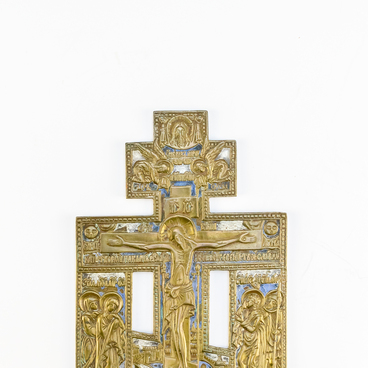The icon “Nicholas the Wonderworker from the village of Kuyuki” is a copy of the famous icon with the same name. The villagers have a legend that the very first miraculous icon appeared there at the end of the 19th century. A small image of about the same size as the museum exhibit sailed to the village along the Kuyukovka River in 1897.
The day before, there was a heavy downpour with a thunderstorm, which turned the placid river into a stormy stream. The water washed away the banks and exposed layers of rubble stone. The peasants began to mine it, and at that moment, two young brothers Guriy and Alexy discovered a chased copper icon of Nicholas the Wonderworker floating on the water. It was as thick as a sheet of paper, and its size was that of a matchbox, but the image was very clear.
When the priest came to the place where the icon had been found, the people built something like a lectern out of stones — this is the name of a high reading desk with a sloping top, on which icons and books are placed in the church. They covered the stand with a white tablecloth and laid the image they had found on the cloth.
In the following days, believers began to gather and come to the sacred place. At the same time, the icon became known for miraculous healings. The news spread throughout the neighborhood, and pilgrims began to come to Kuyuki. With the blessing of the Archbishop of Kazan and Sviyazhsky, a linen cover was hung above the icon and a candlestick was placed next to it: the pilgrims donated candles and oil, so a fire was constantly lit next to the icon.
Believers came in great numbers, there could be up to five thousand pilgrims a day. Witnesses said that people brought their immobilized relatives and the latter left on their own feet. Thanks to several years of generous donations, the locals were able to build a stone St. Nicholas church, and the miraculous icon was brought there and put in a special revered place.
Later, the image was kept in Kazan, in the church on Bolshaya Prolomnaya Street (later known as Nikolai Bauman Street). But in 1997, the icon was stolen, and since then its whereabouts have been unknown.
The day before, there was a heavy downpour with a thunderstorm, which turned the placid river into a stormy stream. The water washed away the banks and exposed layers of rubble stone. The peasants began to mine it, and at that moment, two young brothers Guriy and Alexy discovered a chased copper icon of Nicholas the Wonderworker floating on the water. It was as thick as a sheet of paper, and its size was that of a matchbox, but the image was very clear.
When the priest came to the place where the icon had been found, the people built something like a lectern out of stones — this is the name of a high reading desk with a sloping top, on which icons and books are placed in the church. They covered the stand with a white tablecloth and laid the image they had found on the cloth.
In the following days, believers began to gather and come to the sacred place. At the same time, the icon became known for miraculous healings. The news spread throughout the neighborhood, and pilgrims began to come to Kuyuki. With the blessing of the Archbishop of Kazan and Sviyazhsky, a linen cover was hung above the icon and a candlestick was placed next to it: the pilgrims donated candles and oil, so a fire was constantly lit next to the icon.
Believers came in great numbers, there could be up to five thousand pilgrims a day. Witnesses said that people brought their immobilized relatives and the latter left on their own feet. Thanks to several years of generous donations, the locals were able to build a stone St. Nicholas church, and the miraculous icon was brought there and put in a special revered place.
Later, the image was kept in Kazan, in the church on Bolshaya Prolomnaya Street (later known as Nikolai Bauman Street). But in 1997, the icon was stolen, and since then its whereabouts have been unknown.



